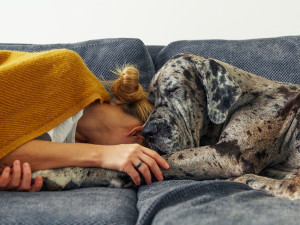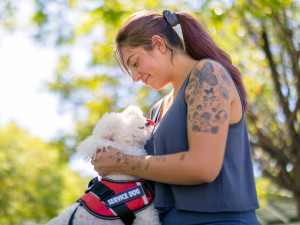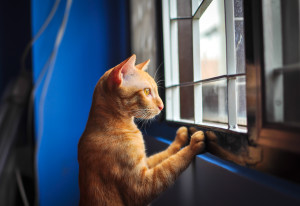Pets Are Incredibly Good For Your Mental Health
Experts share the science-backed ways our pets offer us emotional support

Share Article
When writer and brand consultant Jayme Cyk found herself in a dark place during the pandemic, it was her dog, Kanushi, who ended up being the most effective form of solace. “I’ve struggled with my mental health for a long time, but over the pandemic my eating disorder and the depression that followed intensified,” says Jayme.
Throughout her darkest and loneliest days, Kanushi was always by her side. “So often, for me at least, your significant other or family or friends don’t know what to say when you’re in this state, but Kanushi doesn’t have to say anything at all. His furry body closely lined against mine, and his smell, which I liken to a newborn baby scent, helps to pull me out of the dark place I’m in.”

Get (totally free) deals for food, treats, accessories, tech and way more pet parenting must-haves.
And there is growing evidence to support Jayme’s experience. A number of studies have shown that interactions with animals increase endorphins, oxytocin, prolactin and dopamine, says Sue Gilberti, co-founder and VP of Pet Partners of Central New Yorkopens in new tab, a volunteer organisation that brings pets to visit schools, nursing homes and hospitals. “These are the hormones associated with blood pressure regulations, pain relief, stress relief and joy,” says Gilbert.
Why are pets so good for our mental health?
There are number of theories as to why pets have such a positive impact. Leanne Nieforth Bomkamp, a PhD candidate at Purdue University working at the school’s Organisation for Human-Animal Interaction Research and Education (OHAIRE), points to attachment theory, which suggests that the bond we form with animals provides companionship and non-judgmental social support. “As non-judgmental and positive social partners, pets decrease our stress levels and increase our joy,” says Bomkamp. Anyone who has returned home after an awful day to be greeted by their dog, tail wagging and thrilled to see them, can attest to that.
“No matter what kind of day someone is having, when they interact with one of our pets their whole demeanour changes, because that pet is approaching them with unconditional acceptance,” says Gilberti. Even before she pivoted to working with animals full time, Gilberti was keenly aware of their potential for healing. As a teacher at a public school in Syracuse, the principal would often ask her to bring her dog in when a student was having a particularly challenging time. “Just being with the dog for 10 minutes would completely relax the student so that they could better listen to the school psychologist working with them,” she says.
In their work at OHAIRE, researchers have seen psychological and physiological changes in stress and anxiety with pets and military veterans with PTSD, people with physical disabilities and children with autism. For veterans with PTSD, a service dog was correlated with 30 percent lower depression, 21 percent greater ability to participate in social activities, and an overall dip in the stress hormone cortisol.
For those with physical disabilities, a trained service dog led to 10 percent better emotional functioning and 16 percent greater functioning at work or school. And for children with autism, classroom-based animal-assisted intervention resulted in a 54 percent increase in social behaviours (something they struggle with) and a 43 percent reduction in physiological indicators of anxious activation.
Many animals boost mental wellness, not just dogs and cats
During the pandemic, pets took on an even more urgent role in people’s lives. As our networks dwindled amidst social distancing and general uncertainty, pets became a newly important source of social support. “Pets offered a complementary support to the virtual human-to-human social support that many people were forced to turn to,” says Bomkamp. “Additionally, the social support provided by pets may have encouraged individuals to stay active and maintain a consistent routine, thus positively influencing both physical and mental health.” There is also, of course, the direct touch from pets that has its own significantly stress buffering effects.
Whilst there is the greatest amount of research around dogs and horses, they are not the only animals who can serve an emotionally supportive purpose. Sarah Miers, an analyst for the US federal government based in Maryland, points to the healing benefits of her cat. “I inherited my mom’s cat when she passed away, and he has really helped me with my grief,” says Miers. “I have always had cats and they have helped me live through anxiety and depression, but this experience with my mom’s cat has been such an unexpected blessing.”
Holly Siegel, a New York-based senior director of copy and creative, would agree. “I 100 percent have an emotional support cat,” says Siegel. “My partner is not a big cuddler, and my therapist is over Zoom; Avery has been with me for almost 20 years – longer than either of them. She has literally licked tears from my cheeks.”
Pet Partners is a national organisation in the US that registers nine different species as emotional support animals: dogs, cats, rats, horses, llamas/alpacas, birds, potbellied pigs, guinea pigs and rabbits. “The species that are capable of being a registered therapy pet all have recognisable stress signals that a handler can react to,” says Gilberti. At a time when everything is seemingly dubbed ‘self-care’, pet care actually earns the label. It just should not, says Bomkamp, be a replacement for a traditional, evidence-based treatment modality, like therapy. It seems the more help we have, the better.

Fiorella Valdesolo
Fiorella Valdesolo is a writer, editor, brand and creative consultant. She’s worked with New York, Elle, The Wall Street Journal, T, Glamour, Vogue, Women's Health, Nylon, Style.comopens in new tab, Net-a-Porter, and Domino, among others. She is the cofounder and editor-in-chief of the independent food magazine Gather Journal and the author of Pretty: The Nylon Book of Beauty. She lives in Brooklyn with her partner Nate and daughter Aluna. Her dream interview remains Stevie Nicks.
Related articles
![orange cat looking out window]()
Is Your Cat’s Separation Anxiety Ruining Their Life and Yours?
Why your cat freaks out when you’re away (and how to help)
![A woman wearing a knit sweater holding a dog close on the floor of her bedroom.]()
Separation Anxiety in Dogs
Train your dog to stay calm when they’re on their own – instead of sad-singing “All By Myself” until you come home.
![Brown, half breed dog sitting on a chair next to his owner, a blonde stylish woman wearing a brown smart suit.]()
Your Dog Can Read Your Mind, Kind Of
Researchers say dogs actually have a pretty good sense of what we’re thinking
![A woman and a dog laying close together on a couch.]()
Paging Dr Doggo
Your pup may know you’re sick before you do





